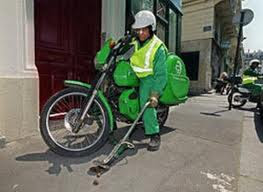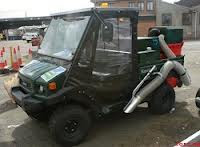In the United States, people who keep track of these things estimate that about 40% of American dog owners leave their dog's poop for someone else to pick up.
Poop scooping laws probably make the legislators feel useful but so far haven't had much of an impact on the poop problem.
What about signs that tell you to pick it up?
They work well in countries like Japan, where everyone is law-abiding.
 |
| A poop that could walk would make it easy! |
Where the signs don't work, France for instance, people must come up with other solutions. In Paris, poop collectors used to suck it up as they rode about on their "motocrottes."
 |
| A French Motocrotte |
Hastings, on the other hand, liked the French idea, and in 2011 purchased four vacuums called "Henry the Hoover."
 |
| All vacuum cleaners are called "hoovers" in England. The verb is "to hoover," as in, "I hoovered the carpet this morning." |
The town council estimated that Henry would save them £420,000 a year.
In 2009, there were plans afoot in a small town in Germany to collect fur or saliva from all 420 resident dogs so as to do DNA matching and fine owners of any poop that might be found.
I can't find any evidence that the scheme ever got off the ground.DNA testing is starting to gain some traction in the U.S., however. As of August of this year, a company called PooPrints tracks down poopetrators for hundreds of property managers in 30 states.
The town of Petah Tivkah, near Tel Aviv, does DNA testing with a twist. If the poop examiner finds your dog's leavings a a marked receptacle, you get a reward--coupons for dog food or toys.
 |
| You get a reward for putting it here, a fine if you leave it on the street. |
If
he finds it anywhere else, you get a fine.
But
sometimes, if the government fails to take action, and the private
sector fails to see any financial incentive for collecting poop, you
just have to take the law into your own hands. This is Super Vaclav.
He
is Prague's self-appointed dog poop enforcer. If he sees your dog
poop, and you don't pick it up, he will punish you by throwing it at
you or smearing it on you. I doubt whether he is still active, but
videos of him from 2011 are widely available.
Does
anyone have any other ideas?
http://www.thesun.co.uk/sol/homepage/news/politics/4498886/.html
http://www.theargus.co.uk/news/10001200.Sussex_dog_walkers_to_be_spied_on_with_CCTV/
http://www.guardian.co.uk/commentisfree/libertycentral/2010/may/25/councils-abusing-covert-surveillance
http://www.digitalspy.com/odd/news/a438424/kent-council-to-dna-test-dog-poo.html
http://www.telegraph.co.uk/news/worldnews/europe/germany/4400064/German-town-plans-dog-DNA-database-to-stop-fouling.html
http://www.huffingtonpost.com/2012/08/21/dna-tests-required-to-ide_n_1819637.html
http://trueslant.com/maryannmott/2009/03/03/dna-testing-catches-slackers-who-dont-scoop-poop/
http://www.freakonomics.com/2008/09/18/our-dog-feces-dream-is-finally-a-reality/
http://gawker.com/5846781/superheros-main-weapon-against-apathy-dog-poop



































